Cheonmachong › Bulguksa Temple » Ancient origins
Articles and Definitions › Contents
- Cheonmachong › Ancient History
- Bulguksa Temple › Ancient History
Ancient civilizations › Historical and archaeological sites
Cheonmachong › Ancient History
Definition and Origins
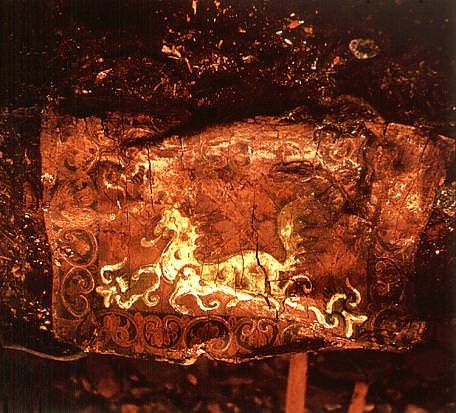
Cheonmachong is a 5-6th-century CE royal tomb of the ancient Silla kingdom of Korea located at the Daereungwon Tomb Complex in Gyeongju. It is popularly known as the 'Heavenly Horse Tomb' because of a painting of that animal on a birch-bark saddle-flap found within it. There were over 140 other treasures inside which included a magnificent gold crown, gold jewellery, a gold girdle, and a blue glass cup. Several items from the tomb feature on the official list of National Treasures of Korea.
TOMB DESIGN
The tomb was excavated in 1973 CE at Gyeongju (Kyongju) the former capital of the Silla kingdom then known as Kumsong or Sorabol. The Silla kingdom ruled the south-eastern portion of Korea between the 1st century BCE and 7th century CE. It would then go on to control the whole peninsula from 668 to 935 CE. Unlike in some other Silla mound tombs, there is no inscription plaque inside it to indicate exactly who the occupant was, but the richness of the artefacts within it and the presence of a gold crown would suggest it is the tomb of a Silla king. The tomb chamber is wood-lined and was covered in a stone mound with layers of clay set between the stones to make the tomb waterproof. Then the whole was covered in an earth mound, leaving no access point. This meant that the tomb did not suffer looting like many other Korean tombs of the Three Kingdoms periodwhich had horizontal entrance passages. The tomb measures 12.7 metres in height and has a diameter of 47 metres.
THE GOLD CROWN
The gold crown found in the tomb, like those from other Silla tombs, is composed of three parts which may have been intended to be worn all together. However, their location in three separate parts of this tomb may indicate that was not the case. The three elements are a diadem, gold cap, and wing-like appendages, presumably to be fitted into the cap. It is not clear whether the crown was meant to be worn, with some scholars suggesting it too delicate and others pointing out wear and tear marks on them which suggest they were used by the occupant when alive.
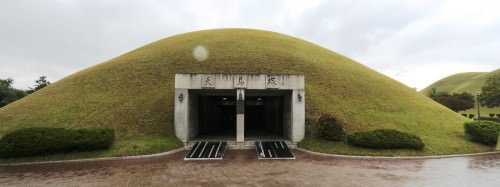
Cheonmachong ('Heavenly Horse Tomb')
The diadem is fitted with tall upright antlers (at the sides) and tree-like formations with U-shaped branches (at the front), which indicate a link with Scytho-Siberian shamanism. Made of thin pieces of cut sheet-gold they are embellished with granulation, punched dots, rivetting, filigree, and suspended disks or spangles. The crown is 32.5 cm high and is the most lavishly decorated of all the Silla crowns so far found. It has pendants of twisted gold ending in 58 crescent-shaped jade pendants known as gogok in Korean and very similar to those found in ancient Japan where they are called magatama ; they symbolise new life. Two gold chain pendants hang from either side of the crown and end in a three-dimensional pointed-leaf shape. They both have leaf-shaped spangles and an extra addition of gold bunched leaves and spangles at the top much like Silla earrings in design. The crown is number 188 on the official list of National Treasures of Korea.

Silla Gold Crown from Cheonmachong
The gold cap, another National Treasure (no. 189), is around 18 cm in height and made from four separate gold sheets which display various intricate openwork patterns. The sheets are joined together by gold rivets and wiring while the rim has decorative punched holes. The wing-like parts of the ensemble, two individual pieces, may represent bird's wings which were potent symbols of Korean shamanism as they symbolised flight in the spiritual world. One wing is made from three gold sheets, measures 45 cm across, and is decorated with over 400 tiny spangles individually attached with gold wire. The second wing piece resembles an angel with spread wings, measures 21.5 x 22 cm, and is similarly decorated with spangles and embossed circles along its edges.
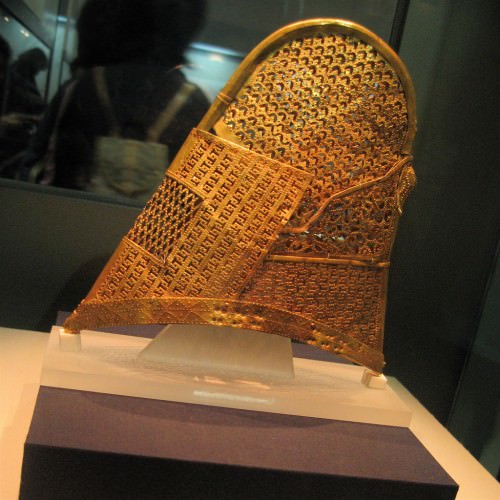
Gold Silla Cap
THE HEAVENLY HORSE
Horses had long been of importance in ancient Korean culture. Traditionally the peninsula was considered to have been first settled by horse-riders from the north, and many tombs contain horse trappings. Horses were also an export to Korea's major trading partner China over the centuries. A horse was sacrificed with the king of this tomb and a birch-bark flap on its saddle is painted with a figure of a white winged horse which has given the tomb its popular name of the 'Heavenly Horse Tomb'. The horse is painted in full gallop with flaring mane and tail. It also has curious crescent-shaped markings on its body which some scholars link to inlaid jades from Scythia. It is one of the earliest paintings of ancient Korea. Other saddle flaps in the tomb, carefully stored in a wooden chest, are similarly painted but this time with horsemen and one with a phoenix.
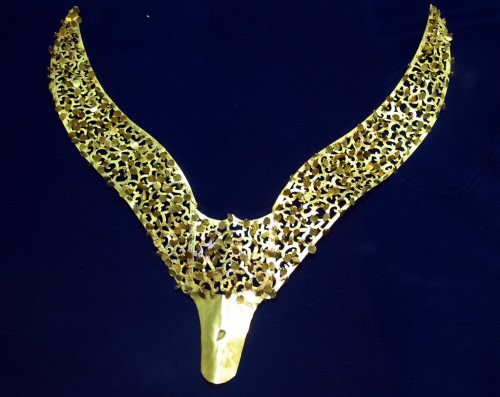
Gold Silla Crown Ornament
OTHER TREASURES
The occupant of the tomb was placed in a wood coffin which was laid on a stone platform. Inside was a sword, the gold diadem of the crown, and the body wore gilt-bronze openwork shoes and various jewellery items – earrings, rings, bracelets, and a magnificent gold girdle. The girdle, another National Treasure (no. 190), measures 125 cm and has 13 pendants, the longest being 73.5 cm long. The belt has dragon carvings decoration and consists of 44 thin joined gold plates with a buckle and tongue at each end. The gold pendants are miniature representations of tools and items perhaps worn by state officials, a tradition probably based on the practice of nomadic tribes-people wearing real tool belts. The pendants include tweezers, a small knife, two writing tablets, a fish, a perfume bottle, two jade gogok, and a weight. Finally, outside the coffin and stored in a chest were various horse trappings, bronze bowls and cups, glass beads, lacquer work, and pottery.
This article was made possible with generous support from the British Korean Society.
Bulguksa Temple › Ancient History
Definition and Origins
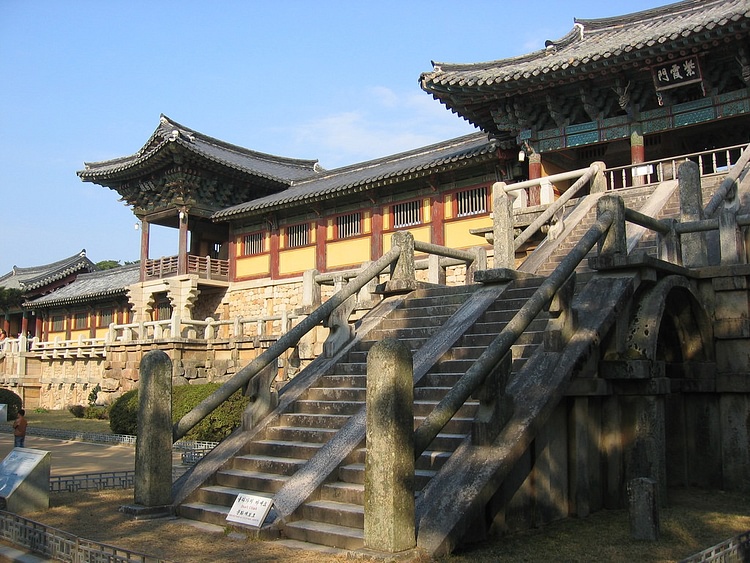
The Bulguksa Temple (aka Pulguk-sa Temple or 'Temple of the Buddha Land') was built in the 8th century CE on the wooded slopes of Mt. Tohamsan at the ancient Silla capital of Kumsong (modern Gyeongju, South Korea ). The Buddhisttemple, after suffering a destructive fire, now stands restored but is only a fraction of its original size. The temple and nearby Seokguram Grotto with its huge seated Buddha statue is recognised by UNESCO as a World Heritage Site.
The temple was built on an earlier foundation set when the territory was controlled by the Baekje (Paekje) kingdom (18 BCE - 660 CE). The chief architect of Bulguksa is traditionally credited as Kim Dae-seong (700-774 CE), the Chief Minister or chungsi of the Unified Silla kingdom which ruled Korea from 668 to 935 CE. The period saw a great deal of Buddhist architecture spring up across Korea, but Bulguksa is widely regarded as one of the finest complexes dedicated to the official state religion of Korea.
THE LAND OF BUDDHA
The complex, as its name suggests, was designed to represent the land of Buddha, that is paradise. For this reason, there are three principal zones: Birojeon (Vairocana Buddha Hall), Daeungjeon (Hall of Great Enlightenment and main temple), and Geungnakjeon (Hall of Supreme Bliss). The halls, constructed in wood and stone with tiled roofs, are each built on a raised stone terrace.

Daeungjeon Hall, Bulguksa
This architectural representation of paradise, which rises symmetrically from a lotus lake, is symbolically entered via two stone bridges and a large staircase, reminding the visitor that they are leaving the earthly realm behind them and stepping into the sacred realm of Buddha. The entrance gate, known as the Mauve Mist Gate ( Chaha- mun ) is approached by the 'cloud bridge' staircase. The visitor must climb a lower flight of steps known as the Bridge of White Clouds ( Paekun - gyo ) and then an upper flight with the name Bridge of Azure Clouds ( Chongun - gyo ). Besides the three large halls, the complex included floating pavilions and living quarters for monks as it also functioned as a monastery. The combined floor space of all of these structures was said to cover 2,000 kan (one kan being the space within four columns).The temple complex was so large and built with such precise mathematical and geometrical considerations that it took almost 40 years to complete, beginning with the traditional start date of 751 CE and finishing in 790 CE.
DABOTAP & SEOKGATAP PAGODAS
Although the original wooden buildings of Bulguksa have long since disappeared the temple does have two surviving stone pagodas – the Dabotap (Tabo-tap or 'Pagoda of Many Treasures') and Seokgatap (Sokka-tao or 'Pagoda that Casts No Shadow') – which both traditionally date 751 CE. Stone pagodas are Korea's unique contribution to Buddhist architecture, and they usually stood as a pair in a courtyard in front of the main temple hall, as was the case with these two at Bulguksa which stand before the Daeungjeon Hall.
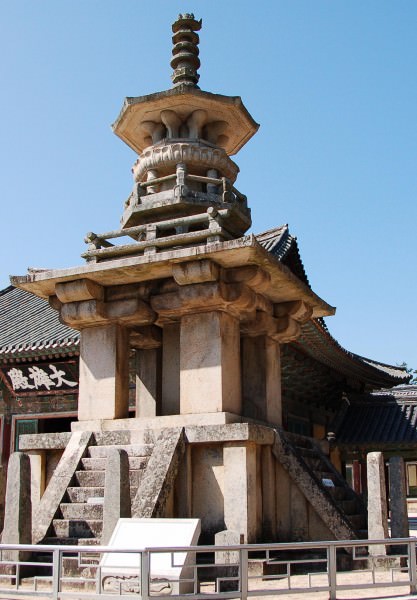
Dabotap Pagoda, Gyeongju
The Dabotap pagoda, which represents the Dabo Buddha, is the more complex of the two and stands at the east side. It has a square base with a columned pavilion accessed by a short flight of stairs on each of the four sides. The pavilion may once have housed an image of Buddha and at the top of the western stairs is a stone lion, a design which may originally have been repeated on the other three staircases. Above are multiple octagonal levels with columns in the form of bamboo stalks and then circular, flower-shaped layers at the top. The Seokgatap, on the west side and representing Sakyamuni Buddha, is a simpler affair and has a large square base and then three prominent square levels topped by a thin spire. Excavation around the Seokgatap pagoda in 1966 CE brought to light a sarira (reliquary casket) containing the world's oldest woodblock-printed document, a copy of the Dharani sutra.
LATER HISTORY & RESTORATION
Many of the temple complex's wooden buildings were, unfortunately, destroyed during the Japanese invasions known as the Imjin Wars (1592-8 CE). Restorations were made over the centuries, often based on ancient descriptions, but the complex is much smaller than the original. The two pagodas and two of the bridges all feature on the official list of National Treasures of Korea.
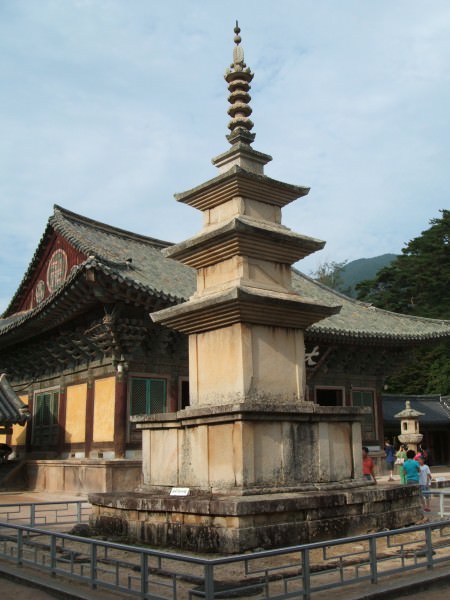
Seokgatap Pagoda, Gyeongju
SEOKGURAM GROTTO
Nearby Bulguksa, set into the upper south-eastern slopes of the Tohamsan mountain, is the Seokguram Grotto (Sokkuram).This Buddhist cave temple was constructed as an artificial grotto between 751 and 774 CE, again by Kim Dae-seong. The circular inner chamber has a domed roof and a white granite statue of the Sakyamuni Buddha which is 3.45 metres high. The walls of the grotto are decorated with 41 figure sculptures set in niches. Seokguram features at position no. 24 on the official state list of National Treasures of Korea.
This article was made possible with generous support from the British Korean Society.
LICENSE:
Article based on information obtained from these sources:with permission from the Website Ancient History Encyclopedia
Content is available under License Creative Commons: Attribution-NonCommercial-ShareAlike 3.0 Unported. CC-BY-NC-SA License